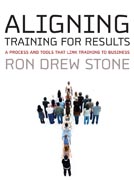
Aligning training for results: a process and tools that link training to business
Stone, Ron Drew
A potent, comprehensive, and versatile resource that cuts through the flood of models and processes to help guide trainers through assessing, designing, and delivering training solutions that achieve real and measurable results. Fullof evidence-based tools, templates, strategies, and assessments, this book communicates a foundation of concepts and principles, and a systematic process demonstrating how to create, sustain, and align training solutions. This one-of-a kind book addresses all aspects of the training process, beginning with needs assessment and ending with determining transfer risk and designing transferstrategies. INDICE: About This Book. Tables, Figures, and Exhibits. Web Site Tools. Preface. Introduction. Audience. How This Book Is Organized. Getting the Most from This Resource. Key Terms Used Throughout the Book. 1 Thinking Performance in the Twenty-First Century. Performance Is Our Business. Performers Do Have a Choice. Viewing Training Through a Different Lens. Client-Friendly PerformanceFramework. Business Outcome. Execution in the Work Setting. Performance Readiness. Preferences. The Training and Performance Process. Top Three Barriers toPerformance. Summary. 2 Five Key Factors of Alignment. Its About Results. Performance Results Defined. Keys to Alignment and Linkage. Factor One: Business Outcome Need Is Identifi ed Up Front. Factor Two: The Training and PerformanceDesign Is Guided by the Root Cause and Relevant Needs. Factor Three: Development and Delivery Are Focused and Linked to the Training and Performance Design. Factor Four: Following Delivery, Performers Choose to Execute in the Work Setting. Factor Five: Execution Is Linked to One or More Business Outcome Measures. Summary. 3 PAL: The Alignment of Our Processes. With a New View Come New Processes. Introduction to the PAL Process. Phase One: Situational Needs Assessment and Performance Design. Step 1: Scope the Project and Utilize Six Signalsto Determine Assessment Strategy. Step 2: Conduct Detailed Assessment and Analysis and Identify Alternative Solutions. Step 3: Administer Situational Risk Assessment and Analysis. Step 4: Propose the Solution and Negotiate Performance Alignment Contract. Step 5: Go/No Go Solution Decision. Phase Two: Design and Development. Step 6: Finalize Delivery Design and Strategy for Performance Transfer. Step 7: Develop and/or Acquire Focused Performance Solution Components. Phase Three: Delivery and Execution. Step 8: Implement Pre-Engagement Action. Step 9: Deliver Performance Solution and Assess Learning Readiness and Initial Reaction. Step 10: Trigger Transfer Strategy and Work Setting Execution. Phase Four: Verifi cation and Follow-Up. Step 11: Rapid Verifi cation of Results and Follow-Up Action Steps. Guiding Principles. Summary. 4 Situational NeedsAssessment: Opening the Door. A Process with Many Names. Getting Started. TwoRoles for Needs Assessment. Proactive Role. Client Request Role. Client Key Behavior and Suggested Solutions. Client Resistance to Our Processes. The Initial Meeting: Let the Client Talk. Step 1 of the PAL Process: Scope the Project.The Six Signals. Intake Scope and Alignment Document. Summary. 5 Situational Needs Assessment: The Analysis. Step 2 of the PAL Process: Conduct Detailed Assessment and Analysis. The Approach. The Strategy. Sampling. Data Collection Methods and Sources. Data Collection Methods. Data Collection Sources. DetailedAnalysis. Execution Gap Analysis. Root Cause Analysis. The Acid Test. Step 3 of the PAL Process: Administer Situational Risk Assessment and Analysis. The Guiding Objectives and Measures. Risk Analysis: Assessing the Need for a Transfer Action and Strategy. Summary. 6 Aligning and Proposing the Solution. Believe in Your Solution. Infl uencing the Client. Step 4 of the PAL Process: Propose the Solution and Negotiate Performance Alignment Contract. Educating the Client. Negotiating the Solution and the Performance Alignment Contract. Evaluation Inquiry. Step 5 of the PAL Process: Go/No Go Decision. Forecasting the Return on Investment. Summary. 7 Aligning Design and Development. The Alignment Continues. The Phase Two Handoff. Step 6 of the PAL Process: Finalize Delivery Design and Transfer Strategy. The Handoff Briefing. Step 7 of the PAL Process: Develop or Acquire Focused Solution Components. Key Factors for Learning and Performance. The Training Managers Role. Summary. 8 Aligning Delivery and Execution. Enabling the Performer. Phase Three of the PAL Process. Step 8 of the PAL Process: Implement Pre-Engagement Action. Step 9 of the PAL Process: DeliverPerformance Solution and Assess Readiness. The Delivery. Learner Readiness and Initial Reaction. Step 10 of the PAL Process: Trigger Transfer Strategy and Execution. The Follow-Up Transfer Action and Strategy. Developing a Transfer Strategy. The Signifi cance of Active Management Reinforcement. Summary. 9 Rapid Verifi cation of Results. In The End Its Results That Count. The Evaluation Decision. Evaluation Framework. Step 11 of the PAL Process: Rapid Verifi cation of Results. Step 1: Determine Purpose and Verify Sponsorship for Evaluation.Step 2: Develop Detailed Plans for Low-Intensity Rapid Verifi cation Strategy. Step 3: Collect and Analyze Readiness Data. Step 4: Collect and Analyze Follow-Up Performance Data. Step 5: Communicate Findings and Recommend Follow-Up Action. Summary. 10 Cultivating and Sustaining Sponsorship. Contribution and Survival. Importance of Sponsorship. Infl uencing Sponsorship. Channel One: Direct Use Knowledge. Channel Two: Casual Indicators. Channel Three: Communicationof Demonstrated Results. The Outside View. Its Time to Stop Doingand Start Doing. Working Our Processes. A Few Closing Thoughts. Summary. Bibliography. About the Author. Index.
- ISBN: 978-0-470-18175-1
- Editorial: John Wiley & Sons
- Encuadernacion: Cartoné
- Páginas: 256
- Fecha Publicación: 06/11/2008
- Nº Volúmenes: 1
- Idioma: Inglés
